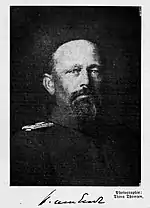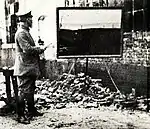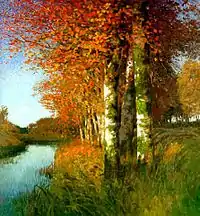Hans am Ende
Hans am Ende (31 December 1864, Trier – 9 July 1918, Stettin) was a German Impressionist painter.


In 1889 he co-founded the artists' colony in Worpswede with Fritz Overbeck, Otto Modersohn, and Heinrich Vogeler. In 1895 this group exhibited in the Kunsthalle Bremen and at the Glaspalast in Munich, which brought them national recognition. In 1900 the poet Rainer Maria Rilke travelled to Worpswede and befriended the artist's colony, eventually writing essays about each of its members.
Amongst his students at the Künstlerkolonie Worpswede was Anna Feldhusen, who was interested in Ende's skills in etching.[1]
He volunteered for the army at the outbreak of the First World War, serving in an infantry regiment. On 10 April 1918 he was severely wounded near Mesen and taken to the hospital in Stettin, where he died. His grave is preserved in the Worpswede Cemetery.

See also
Notes
- Jacob, Inge. "Feldhusen, Anna". Bremer Frauenmuseum e.V. Retrieved 8 January 2021.
References
- Otto Dziobek (1922). Geschichte des Infanterie-Regiments Lübeck (3. hanseatisches) Nr. 162
- Rainer Maria Rilke (1955–66) Sämtliche Werke. Band 1–6, Band 5, Wiesbaden and Frankfurt a.M.
- Rainer Maria Rilke (2007) Worpswede: Fritz Mackensen, Otto Modersohn, Fritz Overbeck, Hans am Ende, Heinrich Vogeler. Neuausgabe Insel, Frankfurt a. M.; 10th ed. ISBN 978-3-458-32711-0
- Sigrid Welte-Wortmann (1987). Die ersten Maler in Worpswede, Worpsweder Verlag, ISBN 3-922516-00-9
- Margarete Braun-Ronsdorf (1953), "Am Ende, Hans", Neue Deutsche Biographie (NDB) (in German), 1, Berlin: Duncker & Humblot, pp. 246–246
External links
 Media related to Hans am Ende at Wikimedia Commons
Media related to Hans am Ende at Wikimedia Commons- Entry for Hans am Ende on the Union List of Artist Names
- Literature by and about Hans am Ende in the German National Library catalogue
- Rainer Maria Rilke on Hans am Ende
- Exhibits and gallery of work (in German)